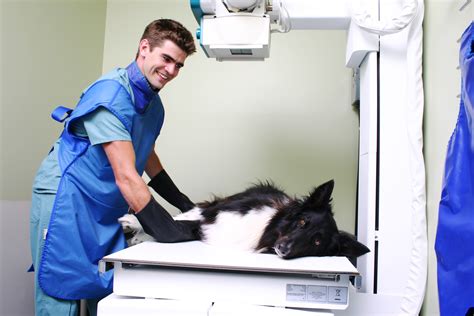Introduction
Veterinary radiology is a specialized field of veterinary medicine that is crucial in diagnosing and treating animal diseases and injuries. Veterinary radiologists use advanced imaging technologies such as X-rays, computed tomography (CT), and magnetic resonance imaging (MRI) to create high-quality images of the animal’s internal organs and structures. This allows for precise diagnosis and informed treatment planning, significantly improving patient outcomes. If you’re passionate about animals and have a knack for technology, a career as a veterinary radiologist could be an ideal fit for you. This comprehensive guide will provide you with all the information you need to embark on this rewarding path.

Educational Pathway
Earning a Doctorate of Veterinary Medicine (DVM)
- Duration: 4 years of rigorous academic and clinical training.
- Curriculum: Includes coursework in anatomy, physiology, pathology, and veterinary medicine.
- Clinical Rotations: Provide hands-on experience in various animal species and medical specialties.
Veterinary Radiology Residency
- Duration: 3-4 years of specialized training in veterinary radiology.
- Program Accreditation: Ensure the program meets rigorous standards set by the American College of Veterinary Radiology (ACVR).
- Clinical Caseload: Residents diagnose and interpret a wide range of imaging studies under the supervision of board-certified veterinary radiologists.
- Research Involvement: Contribute to ongoing research projects or conduct independent studies.
Board Certification
After completing the residency program, aspiring veterinarians can pursue board certification in veterinary radiology by passing the American College of Veterinary Radiology (ACVR) examination. This certification demonstrates the veterinarian’s expertise and commitment to the field of veterinary radiology.
Career Opportunities
Veterinary Diagnostic Imaging Centers
- Provide diagnostic imaging services to veterinarians and pet owners.
- Typical Responsibilities: Interpret X-rays, CT, MRI, and other imaging studies.
- Average Salary: $120,000-$200,000 per year.
Veterinary Teaching Hospitals
- Train veterinary students and provide diagnostic imaging services.
- Typical Responsibilities: Conduct lectures, supervise students, and perform imaging procedures.
- Average Salary: $80,000-$150,000 per year.
Research Institutes
- Conduct research in veterinary imaging technologies and diseases.
- Typical Responsibilities: Develop new imaging techniques, study the effects of diseases on animal anatomy, and publish findings.
- Average Salary: $60,000-$120,000 per year.
Industry
- Collaborate with companies that produce and market veterinary imaging equipment.
- Typical Responsibilities: Provide technical support, conduct product evaluations, and develop new products.
- Average Salary: $70,000-$150,000 per year.
Skills and Qualities
- Strong understanding of veterinary medicine and imaging technology.
- Excellent communication and teamwork skills.
- Ability to think critically and solve complex problems.
- Compassionate and caring nature.
- Attention to detail and accuracy.
Future Innovations and Applications
The field of veterinary radiology is constantly evolving with the advancement of technology. Some innovative applications include:
- Digital Radiography (DR): Provides enhanced image quality and allows for quick and easy transfer of images.
- Ultrasound with Artificial Intelligence (AI): Utilizes AI algorithms to improve image interpretation and accuracy.
- Veterinary Virtual Reality (VR): Allows veterinary professionals to experience and interact with 3D anatomical models for improved surgical planning and training.
- Radiomics in Veterinary Oncology: Analyzes large amounts of imaging data to identify patterns that can predict tumor behavior and response to treatment.
- Quantitative Imaging in Veterinary Cardiology: Uses advanced image analysis techniques to assess cardiac function and detect subtle abnormalities.
Tips and Tricks
- Start early: Begin exploring veterinary radiology during your DVM program by taking elective courses or participating in research.
- Gain practical experience: Seek opportunities for shadowing and internship in veterinary radiology clinics.
- Networking: Attend veterinary conferences and workshops to connect with professionals in the field.
- Stay updated: Keep up with the latest advancements in veterinary radiology technology and imaging techniques.
Common Mistakes to Avoid
- Underestimating the academic rigors: Veterinary radiology is a demanding specialty that requires a solid foundation in veterinary medicine and a commitment to continuous learning.
- Neglecting clinical experience: Ensure you gain hands-on experience in veterinary radiology to develop your diagnostic skills.
- Ignoring board certification: Board certification is a crucial step in establishing your credibility and expertise as a veterinary radiologist.
- Overlooking the importance of communication: Veterinary radiologists must effectively communicate their findings and recommendations to veterinarians and pet owners.
- Lacking compassion and empathy: Animals under radiographic examination may be anxious or uncomfortable. It’s essential to handle them with care and compassion.
Conclusion
A career in veterinary radiology offers the unique opportunity to combine your passion for animals with your interest in technology. Veterinary radiologists play a vital role in diagnosing and treating animal diseases, improving their quality of life, and advancing the field of veterinary medicine. By following the educational pathway, developing the necessary skills, and staying abreast of advancements, you can embark on a fulfilling career as a veterinary radiologist.
Table 1: Key Figures in Veterinary Radiology
| Statistic | Figure |
|---|---|
| Number of ACVR Diplomates | 1,300+ |
| Average salary | $120,000-$200,000 per year |
| Growth rate for the profession | 10% from 2022-2032 |
Table 2: Educational Timeline for Veterinary Radiology
| Degree | Duration | Accreditation |
|---|---|---|
| DVM | 4 years | AVMA |
| Radiology Residency | 3-4 years | ACVR |
| Board Certification | – | ACVR |
Table 3: Career Options for Veterinary Radiologists
| Setting | Responsibilities |
|---|---|
| Veterinary Diagnostic Imaging | Interpret imaging studies |
| Veterinary Teaching Hospitals | Train students, diagnose animals |
| Research Institutes | Conduct research on animal diseases |
| Industry | Collaborate with imaging companies |
Table 4: Tips for Aspiring Veterinary Radiologists
| Tip | Description |
|---|---|
| Start early | Explore veterinary radiology during DVM program; shadow professionals |
| Gain practical experience | Seek internships and clinical rotations in veterinary radiology clinics |
| Network | Attend conferences, workshops to connect with professionals in the field |
| Stay updated | Keep up with advancements in technology and imaging techniques |
